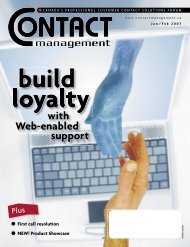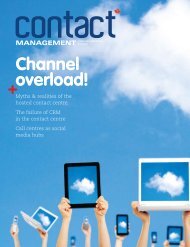Staying ahead of the pack - Contact Management
Staying ahead of the pack - Contact Management
Staying ahead of the pack - Contact Management
Create successful ePaper yourself
Turn your PDF publications into a flip-book with our unique Google optimized e-Paper software.
Unified<br />
Communications<br />
Integrating UC technologies<br />
with legacy systems<br />
This article helps contact centre executives understand business, technology and<br />
personnel considerations for successfully integrating unified communications<br />
(UC) services in a contact centre with legacy systems. It addresses: business and<br />
technology factors driving greater integration <strong>of</strong> UC services with legacy contact<br />
centre systems; strategies to ensure seamless integration <strong>of</strong> UC services; and<br />
benefits to <strong>the</strong> contract centre <strong>of</strong> integrating UC services. BY PAUL ADAMS<br />
Unified Communications<br />
(UC) continues to<br />
emerge as an invaluable<br />
customer relationship<br />
management tool in contact centres<br />
for its ability to more quickly link<br />
internal experts and knowledge<br />
workers with agents, drive<br />
efficiencies through collaboration,<br />
empower agents that are homebased,<br />
remote or equipped with<br />
mobile devices, and improve <strong>the</strong><br />
customer experience.<br />
Interest among organizations<br />
has also been accelerated by <strong>the</strong><br />
shift from premise-based UC<br />
solutions in <strong>the</strong> contact centre<br />
to hosted UC, which can deliver<br />
more dramatic cost savings, new<br />
service options for organizations<br />
that could not previously afford or<br />
support UC services, and better<br />
business continuity in <strong>the</strong> event <strong>of</strong><br />
downtime. To benefit from contact<br />
centre unified communications,<br />
however, requires full and more<br />
seamless integration <strong>of</strong> UC services<br />
such as unified messaging, video,<br />
presence & IM, enhanced automatic<br />
call distribution (ACD) with legacy<br />
contact centre systems.<br />
Factors driving integration<br />
<strong>of</strong> contact centre UC services<br />
There are key market, business and<br />
technology factors driving greater<br />
demand among enterprises for<br />
unified communications in <strong>the</strong><br />
contact centre in a way that is fully<br />
integrated with voice capabilities and<br />
legacy systems.<br />
• Shift from premise-based to<br />
hosted UC solutions – Enterprises<br />
now have access to on-demand UC<br />
features as a “service,” as opposed<br />
to a premise-based solution that<br />
requires on-site installation,<br />
operation and management <strong>of</strong><br />
UC products. Hosted UC in <strong>the</strong><br />
contact centre makes unified<br />
communications available and<br />
affordable for a broader range <strong>of</strong><br />
organizations, and can be more<br />
seamlessly – and cost effectively<br />
– integrated with legacy contact<br />
centre systems.<br />
• Increased focus on customer<br />
satisfaction – Customer<br />
expectations for <strong>the</strong> contact<br />
centre experience continue<br />
to rise, which means that<br />
organizations are hyper-conscious<br />
<strong>of</strong> customer satisfaction given<br />
<strong>the</strong> brand damage a customer can<br />
video<br />
presence<br />
wreak via online sites and social<br />
networks. The legacy voice system<br />
experience <strong>of</strong> long hold times,<br />
dropped calls and automated<br />
routing black holes are all fodder<br />
for customer dissatisfaction, and<br />
organizations are seeking scalable,<br />
affordable and flexible ways to<br />
create more rewarding customer<br />
experiences.<br />
• Need for consistent customer<br />
experience – Unified<br />
communications are, in a way,<br />
about unifying <strong>the</strong> customer<br />
experience. As <strong>the</strong> number <strong>of</strong><br />
possible customer touch points<br />
expands to mobile devices,<br />
instant messaging<br />
Unified<br />
Communications<br />
ACD<br />
social networks, video and chat,<br />
organizations are recognizing <strong>the</strong><br />
need to ensure that a customer’s<br />
experience remains consistent<br />
and effective.<br />
• Drive to improve contact centre<br />
efficiencies – <strong>Contact</strong> centres are<br />
relentlessly driven to increase<br />
agent efficiency, lower costs, and<br />
increase customer satisfaction<br />
– and balance <strong>the</strong>se competing<br />
objectives appropriately. The<br />
introduction <strong>of</strong> an IP-based architecture<br />
and growth in innovative<br />
Web-based applications enabled<br />
via <strong>the</strong> IP network now allow contact<br />
centre agents to address <strong>the</strong><br />
core objectives in ways that were<br />
never possible with simple legacy<br />
ACD platforms.<br />
Strategies to ensure seamless<br />
integration <strong>of</strong> UC services<br />
Ensuring successful integration <strong>of</strong> UC<br />
with legacy contact centre systems<br />
requires that organizations first<br />
recognize associated challenges,<br />
as well as strategies that can be<br />
employed to ensure <strong>the</strong> process is<br />
seamless. Key challenges include:<br />
email<br />
cellphone<br />
16 contact management.ca March / April 2011













